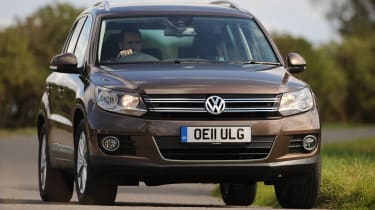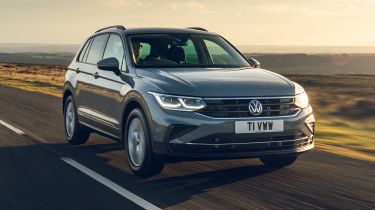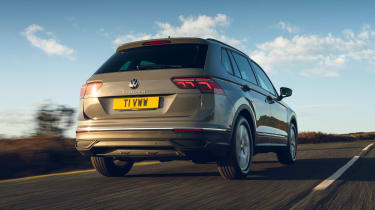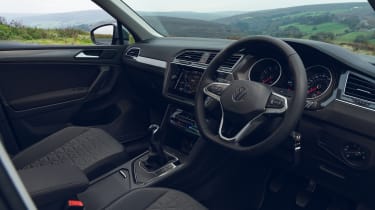Volkswagen Tiguan (2016-2024) review
Perfectly honed for family life, the Volkswagen Tiguan is well-built and practical, but lacks any real sparkle

Just so you know, this is an older review of the 2016-2024 Volkswagen Tiguan. If you are interested in information about the latest Volkswagen Tiguan, or news of upcoming Volkswagen models, please follow the links provided.
Since its introduction in 2007, the Volkswagen Tiguan has proved itself a solid performer rather than a scintillating showstopper, but its lack of sparkle on the road is mirrored by many of its closest crossover rivals. However, the facelifted model is good at many of the things that matter the most in its class.
There’s lots of room inside for a growing family, the cabin is very well built and, although it remains a little dull inside, it offers plenty of up-to-date tech. Overall, this is a very well rounded package, and while some may feel it lacks a bit of personality, its success proves the Tiguan ticks a lot of boxes.
About the Volkswagen Tiguan
The Tiguan SUV has been a popular choice for families since the first one arrived in 2007. So popular in fact, that VW didn’t feel the need to introduce a second-generation until 2016. The current model benefited from a mid-life facelift in 2020, and this year also saw the arrival of the hot Tiguan R variant and Tiguan eHybrid PHEV.
Used - available now

2024 Volkswagen
Tiguan
70,676 milesAutomaticDiesel2.0L
Cash £21,087
2020 Volkswagen
Tiguan
34,263 milesAutomaticDiesel2.0L
Cash £17,300
2022 Volkswagen
Tiguan
50,877 milesAutomaticPetrol1.5L
Cash £19,700
2020 Volkswagen
Tiguan
77,701 milesAutomaticDiesel2.0L
Cash £17,187An all-new Tiguan is set to arrive in 2024 but, despite its impending replacement, a special Black Edition variant was added to the current model line-up in 2023. This trim level includes exclusive black exterior trim panels, alloy wheels and tinted windows to give the Tiguan a more distinctive appearance.
The Tiguan is not cheap compared with rivals such as the Mazda CX-5 and Ford Kuga, because VW has priced its mid-sized SUV to compete with the likes of the Audi Q5 and BMW X3. It’s not quite a premium offering though, and the SEAT Ateca and Peugeot 3008 put it to shame for value, despite coming close in terms of quality. While the Tiguan is similar in size to cars such as the Skoda Karoq and Nissan Qashqai, its prices are similar to those of the larger Skoda Kodiaq.
While the 2020 facelift freshened up the Tiguan’s exterior, the changes didn’t make a radical difference to the way the car looks. VW watchers will notice the similarity to the larger Touareg SUV, but most observers would find it hard to put a finger on the exterior changes. It’s a different story inside though, where a range of tech improvements gave the Tiguan a leg-up. Engines were also revised in the face of continually evolving competition.
The Tiguan shares its engineering and tech with the seventh-generation Golf hatchback and, as previously, it’s available in two body styles. The standard version has five seats, while the roughly 20cm longer Tiguan Allspace is available with five or seven seats.
Discounting the performance R model, the Tiguan is available in a range of trim levels, including Life, Elegance, R-Line and Black Edition variants. An Active trim was also introduced to the range in 2021, but this has since been discontinued. As well as offering more goodies inside, each trim is also clearly distinguished by a different exterior finish, so you can quite easily tell them apart.
Prices for mainstream models start from around £31,000, although the hot R version tops £50,000. You need to be careful adding kit from the options list, particularly with mid- to higher-spec cars, as this will quickly push the price up and incur a higher rate of VED road tax.
There are a number of engines to choose from for the Tiguan, with petrol, diesel and plug-in hybrid power all on offer. Petrol buyers can opt for a 1.5-litre four-cylinder TSI unit which produces either 128bhp or 148bhp. For those after diesel power, there's a 2.0-litre TDI oil-burner in 148bhp or 197bhp form. Both the petrol and diesels all come with the option of a six-speed manual or seven-speed DSG automatic gearbox.
For those seeking to reduce their emissions and running costs, a plug-in hybrid model, called the eHybrid, was added to the range in 2020. This consists of a turbocharged 1.4-litre petrol engine that’s paired with an electric motor. This powertrain allows the Tiguan to travel on pure-electric power for up to 31 miles.
A larger 2.0-litre TSI petrol engine was introduced to the line-up in 2021. This 187bhp unit is available in R-Line and Black Edition models and is mated to Volkswagen’s 4MOTION four-wheel-drive system. The hot Tiguan R is also fitted with this engine, but power is increased to 316bhp.
The 148bhp petrol Tiguan and eHybrid PHEV are both front-wheel-drive only, while the more powerful petrol and diesel variants are available with four-wheel-drive.
Used and nearly new
The Volkswagen Tiguan is one of the most popular SUVs in Europe, and it’s not hard to see why; it takes everything that’s great about the Golf and adds a high driving position, more interior space and a larger boot. The first Tiguan arrived here in 2008 and enjoyed eight years on the market before being replaced by the Mk2. It’s a strict five-seater, so if you’re after seven seats you’ll need the Tiguan Allspace.
Volkswagen Tiguan Mk2: 2016-2023

The Mk2 Tiguan picked up where the old model left off but with improvements in just about every department. It’s an extremely well rounded package, and while some may feel it lacks a bit of personality, its success proves the Tiguan ticks a lot of boxes. It’s not the most exciting SUV out there, but the level of quality and kit is very high. Read our full Volkswagen Tiguan Mk2 buyer’s guide here…
Volkswagen Tiguan Mk1: 2008-2016

Volkswagen didn’t rush to build its first SUV, but when it did – in the shape of the Touareg, which reached dealers in 2003 – it hit the spot. The Touareg was a big car, though, and the brand needed something smaller and more affordable to make an impact with 4x4 fans. That’s exactly what it did with the Tiguan, which arrived here in 2008. Read our full Volkswagen Tiguan Mk1 buyer’s guide here…
Frequently Asked Questions
More reviews
Car group tests
Used car tests
Which Is Best
Fastest
- Name2.0 TSI 320 4Motion R [Black Style Pack] 5dr DSG
- Gearbox typeSemi-auto
- RRP£52,380










